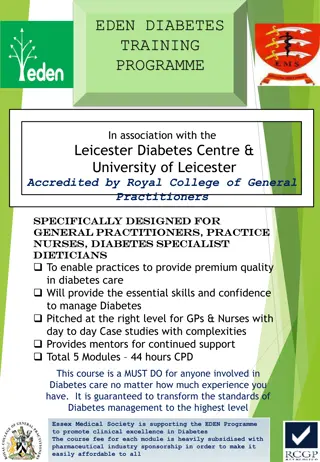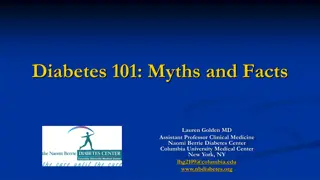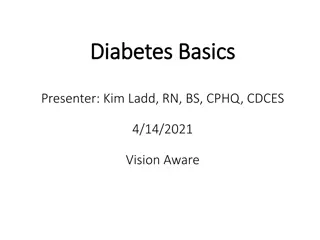
Understanding Diabetic Foot Problems and Assessments
Dive into the world of diabetic foot problems and understand the significance of assessments in managing the condition. Learn about common foot issues associated with diabetes, recommended assessments, and the importance of early intervention to prevent complications like foot ulcerations and lower limb amputations.
Download Presentation

Please find below an Image/Link to download the presentation.
The content on the website is provided AS IS for your information and personal use only. It may not be sold, licensed, or shared on other websites without obtaining consent from the author. If you encounter any issues during the download, it is possible that the publisher has removed the file from their server.
You are allowed to download the files provided on this website for personal or commercial use, subject to the condition that they are used lawfully. All files are the property of their respective owners.
The content on the website is provided AS IS for your information and personal use only. It may not be sold, licensed, or shared on other websites without obtaining consent from the author.
E N D
Presentation Transcript
Session Outline Common Diabetic Foot problems Diabetic Annual Foot review Vascular Foot Problems Referral Pathways
Diabetic foot Introduction Diabetes mellitus is a group of metabolic diseases characterized by hyperglycemia resulting from defects in insulin secretion, insulin action, or both. The chronic hyperglycemia of diabetes is associated with long-term damage, dysfunction, and failure of various organs, especially the eyes, kidneys, nerves, heart, and blood vessels. Diabetic foot is defined as any foot pathology that results directly from diabetes or its long term complications
What Common foot problems have you heard of that are associated with Diabetes?
What Common foot problems have you come across so far? Neuropathy Sensory Motor Autonomic Skin Callus / Corns / Infections (Fungal) Ischaemia Acute Chronic Neuro-ischaemia Ulceration / Infection Charcot Neuroarthropathy Painful Peripheral Neuropathy
Which assessments could be performed?
Which assessments could be performed? Vascular Check the blood flow to the feet Neurological Check the nerve supply to the feet Medical History Check for other associated medical conditions Skin inspection check for any skin damage Foot wear inspection Are the shoes suitable? Biomechanical assessment check how the patient is walking Why are these test necessary?
Diabetic foot ulceration Around 5% of people with diabetes may develop a foot ulcer in any year Foot ulcerations are the commonest cause of hospital admission in people with Diabetes Diabetic Foot Ulcerations are the most common cause of non-traumatic lower limb amputations. An associated amputation rate 15 fold higher than non diabetics Up to 80% of these amputations are thought to be preventable due to referral delays
What do NICE recommend? When examining the feet of a person with diabetes, remove their shoes, socks, bandages and dressings, and examine both feet for evidence of the following risk factors: Neuropathy Limb Ischaemia Ulceration Callus Infection / inflammation Deformity Gangrene Charcot Arthropathy
Classifying the risk status Active Ulceration / Charcot Critical limb Ischaemia / Necrosis Neuropathic Pain Previous Ulceration Previous Amputation Renal replacement >1 risk factor 1 risk factor Ischaemia / Neuropathy / Deformity with Callus No Risk factors
Patient education Early recognition of at risk foot Prompt treatment of complications LOW RISK No Risk factors present GP practice based Foot care education & Annual review normal sensation palpable pulses Emphasise importance of foot care Can progress to moderate risk NICE Guidelines. Diabetic Foot Problems: Prevention and management. 2015.
Refer to Foot protection service for Foot care education & Annual assessment Patient education Early recognition of at risk foot Prompt treatment of complications MODERATE RISK 1 risk factor present Podiatry review and treatment as needed Assess for revascularisation / treatment of painful neuropathy neuropathy or absent pulses or other risk factor Evaluate footwear / insoles NICE Guidelines. Diabetic Foot Problems: Prevention and management. 2015.
Refer to Foot protection service for Intensified foot care education & Annual assessment Patient education Early recognition of at risk foot Prompt treatment of complications HIGH RISK Podiatry review and treatment as needed Assess for revascularisation / treatment of painful neuropathy Previous ulceration or amputation, renal replacement therapy more than 1 risk factor present. Specialist footwear & insoles Treatment plan to reduce risk of ulceration NICE Guidelines. Diabetic Foot Problems: Prevention and management. 2015. www.nice.org.uk
Patient education Early recognition of at risk foot Prompt treatment of complications ACTIVE DIABETIC FOOT Rest & elevate affected foot ULCER or CHARCOT Debridement Urgent referral to either Multidisciplinary Diabetic foot clinic within 24 hours or immediately if limb/life threatening If vascular emergency refer straight to Hub At Brighton Off-loading/Dressings +/- Antibiotics Consider total contact casting Control BM & other CVD risk factors Wound management NICE Guidelines. Diabetic Foot Problems: Prevention and management. 2015. www.nice.org.uk Manage as high risk when ulcer heals
Patient education Early recognition of at risk foot Prompt treatment of complications LIMB THREATENING / LIFE THREATENING FOOT Ulceration with fever or any signs of sepsis. Ulceration with limb ischaemia (see the NICE guideline on lower limb peripheral arterial disease). Clinical concern that there is a deep-seated soft tissue or bone infection (with or without ulceration). Gangrene (with or without ulceration). NICE Guidelines. Diabetic Foot Problems: Prevention and management. 2015. www.nice.org.uk
Practice Cases Case 1 You assess a person with Diabetes and find: Biphasic Pulses 9/10 monofilament Retracted toes and plantar Callus What is the risk category? Would you refer? Moderate Risk Refer to the foot protection team Biomechanical assessment required
Practice Cases Case 2 You assess a person with Diabetes and find: Triphasic Pulses 9/10 monofilament No callus / deformities What is the risk category? Would you refer? Low Risk remain under GP practice supervision
Practice Cases Case 3 You assess a person with Diabetes and find: Biphasic Pulses 6/10 monofilament Plantar ulceration No signs of infection What is the risk category? Would you refer? Active Foot Refer to Diabetic Multidisciplinary Foot team
Practice Cases Case 4 You assess a person with Diabetes and find: Biphasic Pulses 0/10 monofilament Hot swollen foot Recent trauma What is the risk category? Would you refer? Active Foot Refer to Diabetic Multidisciplinary Team Urgently Within 24 hours.
Practice Cases Case 5 You assess a person with Diabetes and find: Monophasic Pulses 4/10 monofilament Some biomechanical issues Recent osteomyelitis and healed What is the risk category? Would you refer? High risk Refer to Foot protection team






















